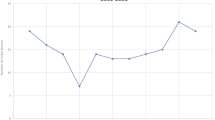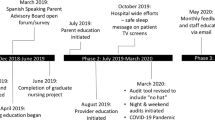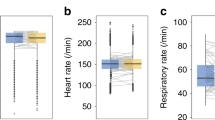Abstract
The aim was to evaluate the effects of Nest Positioning (NP) on motor development, sleep patterns, and weight gain in preterm newborns (PTNB) hospitalized in a neonatal intensive care unit (NICU). This study was constructed based on PRISMA guideline criteria. Systematic research was carried out in electronic databases: MEDLINE via PubMed, Web of Science, Scopus, and VHL-BIREME following the PICOS strategy. Studies with PTNB populations who were hospitalized in the NICU and received therapeutic NP as an intervention strategy in this population were included in this study. We sought outcomes related to sleep patterns, weight gain, and motor development. After selection, 12 studies were included in this systematic review, of which 5 (41.7%) evaluated motor development as their primary outcome, 6 (50%) sleep–wake cycle patterns, and 1 (8.3%), weight gain and, subsequently, hospital discharge. Qualitative results indicate that prolonged exposure to decubitus variations may favor PTNB hospitalized in NICUs acquiring flexor postures, stimulate their midline, and increase their total sleep time. Studies reported no adverse effects regarding the use of NP. Evidence suggests that NP benefits motor development and sleep pattern in PTNB hospitalized in NICUs.
Impact
-
Nest positioning improves sleep quality in preterm newborns hospitalized in neonatal intensive care unit.
-
Nest positioning improves motor development in preterm newborns hospitalized in neonatal intensive care unit.
-
No evidence of nest positioning on weight gain was observed.
-
Half of the included clinical studies showed good methodological quality.
-
Nesting positioning is a secure and cost-effective method.
This is a preview of subscription content, access via your institution
Access options
Subscribe to this journal
Receive 14 print issues and online access
$259.00 per year
only $18.50 per issue
Buy this article
- Purchase on Springer Link
- Instant access to full article PDF
Prices may be subject to local taxes which are calculated during checkout

Similar content being viewed by others
Data availability
The datasets generated during the current study are available from the corresponding author on request.
References
Almadhoob, A. & Ohlsson, A. Sound reduction management in the neonatal intensive care unit for preterm or very low birth weight infants. Cochrane Database Syst. Rev. https://doi.org/10.1002/14651858.CD010333.pub3 (2020).
Griffiths, N., Spence, K., Loughran-Fowlds, A. & Westrup, B. Individualised developmental care for babies and parents in the NICU: evidence-based best practice guideline recommendations. Early Hum. Dev. https://doi.org/10.1016/j.earlhumdev.2019.104840 (2019).
Aylward, G. P. Neurodevelopmental outcomes of infants born prematurely. J. Dev. Behav. Pediatr. https://doi.org/10.1097/00004703-200512000-00008 (2005).
de Jesus Batista, G. et al. Unidade de terapia intensiva neonatal (utin): a importância na sobrevida dos recém nascidos. Res. Soc. Dev. 10, e40910615884 (2021).
Bennet, L., Walker, D. W. & Horne, R. S. C. Waking up too early – the consequences of preterm birth on sleep development. J. Physiol. 596, 5687–5708 (2018).
Bonan K.C., Pimentel Filho Jda C., Tristão R.M., Jesus J.A., Campos Junior D. Sleep deprivation, pain and prematurity: A review study. Arq. Neuropsiquiatr. 73, 147–154 (2015).
Cailleau, L. et al. Quiet sleep organization of very preterm infants is correlated with postnatal maturation. Front. Pediatr. https://doi.org/10.3389/fped.2020.559658 (2020).
Orsi, K. C. S. C. et al. Effect of reducing sensory and environmental stimuli during hospitalized premature infant sleep. Rev. Esc. Enferm. USP. 49, 549–554 (2015).
Aita, M. et al. Effectiveness of interventions on early neurodevelopment of preterm infants: a systematic review and meta-analysis. BMC Pediatr. https://doi.org/10.1186/s12887-021-02559-6 (2021).
Altimier, L. B. Neuroprotective core measure 1: the healing NICU environment. Newborn Infant Nurs. Rev. 15, 91–96 (2015).
Rogers, E. E. & Hintz, S. R. Early neurodevelopmental outcomes of extremely preterm infants. Semin. Perinatol. 40, 497–509 (2016).
Costa, K. S. F. et al. Hammock and nesting in preterm infants: randomized controlled trial. Rev. Bras. Enferm. 72, 96–102 (2019).
dos Santos, L. M., Ribeiro, I. S. & Santana, R. C. B. Identificação e tratamento da dor no recém-nascido prematuro na Unidade de Terapia Intensiva. Rev. Bras. Enferm. 65, 269–275 (2012).
Zahed, M. et al. Posture and movement in very preterm infants at term age in and outside the nest. Child’s Nerv. Syst. 31, 2333–2340 (2015).
Abdeyazdan, Z., Mohammadian-Ghahfarokhi, M., Ghazavi, Z. & Mohammadizadeh, M. Effects of nesting and swaddling on the sleep duration of premature infants hospitalized in neonatal intensive care units. Iran. J. Nurs. Midwifery Res. 21, 552–556 (2016).
Mony, K., Selvam, V., Diwakar, K. & Raghavan, V. R. Effect of Nesting on Sleep Pattern among Preterm Infants Admitted in NICU. www.biomedres.info (2018).
Kahraman, A., Başbakkal, Z., Yalaz, M. & Sözmen, E. Y. The effect of nesting positions on pain, stress and comfort during heel lance in premature infants. Pediatr. Neonatol. 59, 352–359 (2018).
Eskandari, Z., Seyedfatemi, N., Haghani, H., Almasi-Hashiani, A. & Mohagheghi, P. Effect of nesting on extensor motor behaviors in preterm infants: a randomized clinical trial. Iran. J. Neonatol. 11, 64–70 (2020).
Reyhani, T., Ramezani, S., Boskabadi, H. & Mazlom, S. Evaluation of the effect of nest posture on the sleep-wake state of premature infants. Evid. Based Care J. 06, 29–36 (2016).
Tang, X., Bei, F., Sha, S. & Qin, Y. The effects of a postural supporting “New Nesting Device” on early neurobehavioral development of premature infants. J. Neonatal Nurs. 27, 191–199 (2021).
Maguire, C. M. et al. Effects of basic developmental care on neonatal morbidity, neuromotor development, and growth at term age of infants who were born at <32 weeks. Pediatrics. https://doi.org/10.1542/peds.2007-1189 (2008).
Tane, R., Rustina, Y. & Waluyanti, F. T. Nesting with fixation and position to facilitate quiet sleep and oxygen saturation on low-birth weight infants. Compr. Child Adolesc. Nurs. 42, 29–37 (2019).
Vadakkan, A. J. & Prabakaran, V. Comparison of the effect of nesting and swaddling on sleep duration and arousal frequency among preterm neonates: a randomized clinical trial. J. Caring Sci. 11, 126–131 (2022).
Beckmann, C. A. Use of neonatal boundaries to improve outcomes. J. Holist. Nurs. 15, 54–67 (1997).
Nakano, H., Kihara, H., Nakano, J. & Konishi, Y. The influence of positioning on spontaneous movements of preterm infants. J. Phys. Ther. Sci. 22, 337–344 (2010).
Ferrari, F. et al. Posture and movement in healthy preterm infants in supine position in and outside the nest. Arch. Dis. Child Fetal Neonatal Ed. https://doi.org/10.1136/adc.2006.101154 (2007).
Araújo, F. M. et al. Sleep and salivary cortisol in preterm neonates: a clinical, randomized, controlled, crossover study. Rev. Bras. Enferm. 71, 1358–1365 (2018).
Liao, J. H. et al. Nonpharmacological interventions for sleep promotion on preterm infants in neonatal intensive care unit: a systematic review. Worldviews Evid. Based Nurs. 15, 386–393 (2018).
Kassim, Z. et al. Sleeping position, oxygen saturation and lung volume in convalescent, prematurely born infants. Arch. Dis. Child Fetal Neonatal Ed. https://doi.org/10.1136/adc.2006.094078 (2007).
Lan, H. Y. et al. Effects of a supportive care bundle on sleep variables of preterm infants during hospitalization. Res. Nurs. Health 41, 281–291 (2018).
Milgrom, J. et al. Behavioural and cognitive outcomes following an early stress-reduction intervention for very preterm and extremely preterm infants. Pediatr. Res. 86, 92–99 (2019).
Inoué, S., Honda, K. & Komoda, Y. Sleep as neuronal detoxification and restitution. Behav. Brain Res. https://doi.org/10.1016/0166-4328(95)00014-k (1995).
Mahmoodi, N., Arbabisarjou, A., Rezaeipoor, M. & Mofrad, Z. P. Nurses’ awareness of preterm neonates’ sleep in the NICU. Glob. J. Health Sci. 8, 226–233 (2015).
Mirmiran, M. The importance of fetal/neonatal REM sleep. Eur. J. Obstet. Gynecol. Reprod. Biol. 21, 283–291 (1986).
An, S., Kilb, W. & Luhmann, H. J. Sensory-evoked and spontaneous gamma and spindle bursts in neonatal rat motor cortex. J. Neurosci. 34, 10870–10883 (2014).
Akhmetshina, D., Nasretdinov, A., Zakharov, A., Valeeva, G. & Khazipov, R. The nature of the sensory input to the neonatal rat barrel cortex. J. Neurosci. 36, 9922–9932 (2016).
Frank, M. G. Sleep and plasticity in the visual cortex: more than meets the eye. Curr. Opin. Neurobiol. 44, 8–12 (2017).
Moreira, M. E. L., de Andrade Lopes, J. M. & Carvalho, M. O Recém-Nascido de Alto Risco: Teoria e Prática Do Cuidar [online]. Rio de Janeiro: Editora FIOCRUZ, 564 p. Available from SciELO Books (2004).
Sweeney, J. K. & Gutierrez, T. Musculoskeletal implications of preterm infant positioning in the NICU. J. Perinat. Neonatal Nurs. 16, 58–70 (2002).
Barradas, J., Fonseca, A., Guimarães, C. L. N. & Lima, G. M. D. S. Relationship between positioning of premature infants in Kangaroo Mother Care and early neuromotor development. J. Pediatr. (Rio J.) 82, 475–480 (2006).
Vaivre-Douret, L., Ennouri, K., Jrad, I., Garrec, C. & Papiernik, E. Effect of positioning on the incidence of abnormalities of muscle tone in low-risk, preterm infants. Eur. J. Paediatr. Neurol. 8, 21–34 (2004).
Ziegler, S. A. et al. The Coping with and Caring for Infants with Special Needs intervention was associated with improved motor development in preterm infants. Acta Pediatr. 110, 1189–1200 (2021).
Manacero, S. & Nunes, M. L. Longitudinal study of sleep behavior and motor development in low-birth-weight preterm children from infancy to preschool years: sleep behavior and motor development. J. Pediatr. (Rio J.) 97, 44–51 (2021).
Kaneshi, Y. et al. Influence of light exposure at nighttime on sleep development and body growth of preterm infants. Sci. Rep. https://doi.org/10.1038/srep21680 (2016).
Funding
Grant sponsor Programa de Bolsa de Monitoria de Pós-Graduação da Universidade do Estado de Santa Catarina; FAPESC (Fundação de Amparo à Pesquisa do Estado de Santa Catarina); PROAP-AUXEP (Coordenação de Aperfeiçoamento de Pessoal de Nível Superior).
Author information
Authors and Affiliations
Contributions
M.M.C.C. was responsible for the conception, design, acquisition, drafting the manuscript and for giving final approval of the version of the manuscript. S.N.S.R. drafted and critically revised the manuscript. N.A.M. was responsible for drafting the manuscript, data acquisition, analysis, interpretation of data, drafting and for giving final approval of the version of the manuscript. R.O. was responsible for the interpretation of data, drafting, critically revising manuscript and for giving final approval of the version of manuscript. D.M. was responsible for interpretation of data, drafting, critically revising manuscript and for giving final approval of the version of manuscript. L.S.S. was responsible for conception and design, training the student on data acquisition, interpretation of all data, critically revising the manuscript and for giving final approval of the version of manuscript.
Corresponding author
Ethics declarations
Competing interests
The authors declare no competing interests.
Additional information
Publisher’s note Springer Nature remains neutral with regard to jurisdictional claims in published maps and institutional affiliations.
Supplementary information
Rights and permissions
Springer Nature or its licensor (e.g. a society or other partner) holds exclusive rights to this article under a publishing agreement with the author(s) or other rightsholder(s); author self-archiving of the accepted manuscript version of this article is solely governed by the terms of such publishing agreement and applicable law.
About this article
Cite this article
Carneiro, M.M.C., Ribeiro, S.N.S., Menegol, N.A. et al. Nest positioning on motor development, sleep patterns, weight gain in preterm infants: systematic review. Pediatr Res (2024). https://doi.org/10.1038/s41390-023-02972-w
Received:
Revised:
Accepted:
Published:
DOI: https://doi.org/10.1038/s41390-023-02972-w



